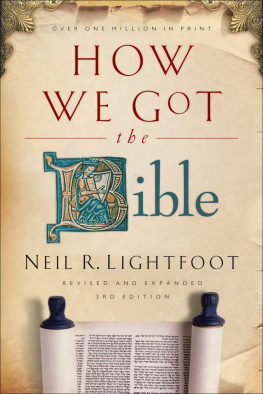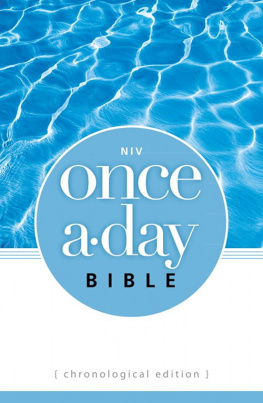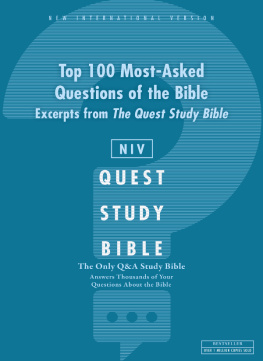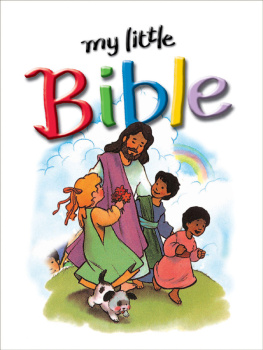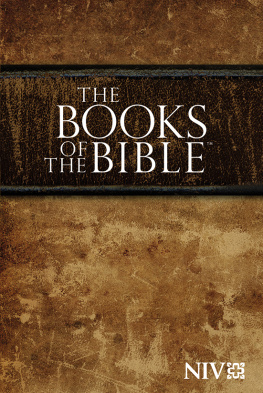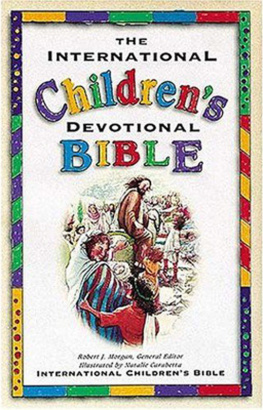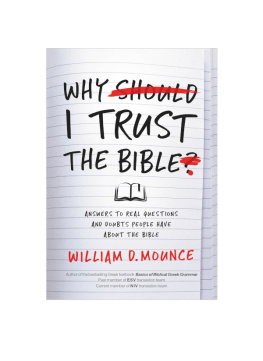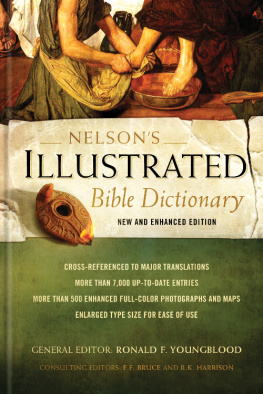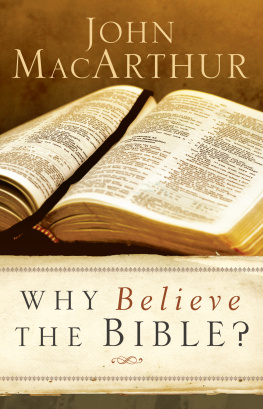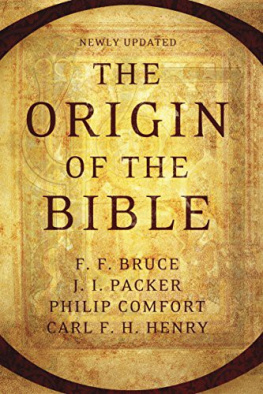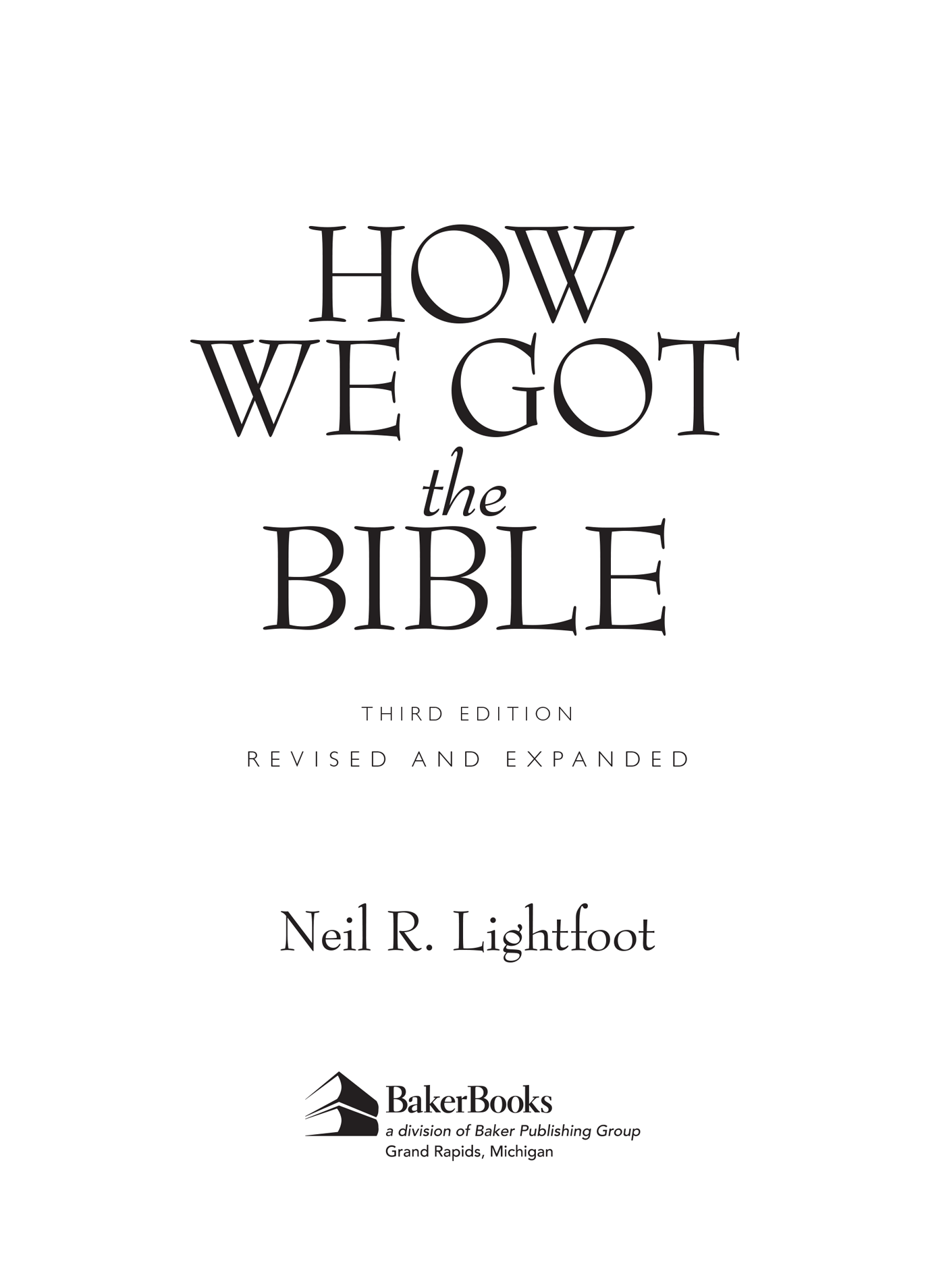
1963, 1988, 2003 by Neil R. Lightfoot
Published by Baker Books
a division of Baker Publishing Group
P.O. Box 6287, Grand Rapids, MI 49516-6287
www.bakerbooks.com
Ebook edition created 2012
Ebook corrections 01.14.2015
All rights reserved. No part of this publication may be reproduced, stored in a retrieval system, or transmitted in any form or by any meanselectronic, mechanical, photocopying, recording, or otherwisewithout the prior written permission of the publisher and copyright owners. The only exception is brief quotations in printed reviews.
Library of Congress Cataloging-in-Publication Data is on file at the Library of Congress, Washington, D.C.
ISBN 978-1-5855-8143-6
Unless otherwise indicated Scripture is taken from the Revised Standard Version of the Bible, copyright 1952 [2nd edition, 1971] by the Division of Christian Education of the National Council of the Churches of Christ in the United States of America. Used by permission. All rights reserved.
Scripture marked NRSV is taken from the New Revised Standard Version of the Bible, copyright 1989 by the Division of Christian Education of the National Council of the Churches of Christ in the United States of America. Used by permission. All rights reserved.
The real text of the sacred writers is competently exact;... nor is one article of faith or moral precept either perverted or lost... choose as awkwardly as you will, choose the worst by design, out of the whole lump of readings.
Richard Bentley
I can only state my own conviction that a study of the history and condition of the Greek text solves far more difficulties than it creates.
J. B. Lightfoot
It is reassuring at the end to find that the general result of all these discoveries and all this study is to strengthen the proof of the authenticity of the Scriptures, and our conviction that we have in our hands, in substantial integrity, the veritable Word of God.
Sir Frederic Kenyon
For Ollie
Contents
Illustrations
Preface to the Third Edition

his study seeks to be a factual and honest account of how the Bible has been preserved and handed down to our generation. The subject is vast and at times complex. It has been my constant aim, therefore, to simplify the material and to state it, so far as possible, in a nontechnical manner. On the other hand, I have tried to get down to the heart of the question, for too many studies of this kind have been content with the mere citing of superficial facts about the Bible. These facts are important and interesting, of course, but they do not tell us how we got the Bible.
The third edition of this book now appears, more than fifteen years after the second edition. Much has happened since that time. In order to bring matters up to date and include other related information, I have completely rewritten almost everything in the book. Additions and changes have been made in every chapter, and five chapters of new material have been added. Readers of this edition will find new material especially on the Greek manuscripts, the Greek papyri, the Septuagint, the Latin Vulgate, the Latin manuscripts, the Hebrew manuscripts, the Dead Sea Scrolls, recent translations of the Bible, and more. Yet, with all these changes, I have tried to keep the book very much as it was from the first.
This third edition, as were its predecessors, is designed for the average reader. But the intention of the book all along has been that it be used for Bible classes, and thus the questions for discussion are an important part of this study. The teacher who leads in the study may find his or her task difficult. It will indeed be difficult unless due care and thought are given to each point. The teacher perhaps will wish to supplement the material by additional readings of selected books and articles in Bible dictionaries and encyclopedias. Both teacher and student should pay attention to the various articles and books referred to in the notes. Most of these are very readable and offer in effect a list of recommended readings.
Although this edition has been expanded to eighteen chapters, several of these may be studied together. If desirable, chapters 3 and 4 can be combined; other possible combinations include chapters 6 and 7, 8 and 9, 10 and 11, and 12 and 13. Nevertheless, each chapter stands on its own and covers significant information. Hopefully, each chapter will prove to be an interesting study in and of itself.
I add that the subject matter of this book, after many years, continues to fascinate me. As a young person, my own questions about the Bible prompted me to begin my own study. This quest was furthered by courses at Duke University under Dr. William H. Brownlee on the Dead Sea Scrolls and under Dr. Kenneth W. Clark on the textual criticism of the New Testament. Since then, study through the years has not only enhanced my interest but has resulted in building my own faith. I am grateful to God for the privilege of studying and teaching his Word.
My special thanks go to Mr. Don Stephenson and Baker Book House for inviting me to do this third edition as a fortieth-anniversary edition. My thanks also are due to Mr. Chad Allen of Baker Books for his editorial assistance and for his arranging the use of some of the photos at a time when I was unable to pursue it. And my thanks especially extend to the readers who have favorably received this bookthough I am aware of its many shortcomings.
My hope is that this new edition may spark again studies of How We Got the Bible. May the Father in heaven enrich our understanding and appreciation of the Sacred Word that is able to instruct us for salvation.
Neil R. Lightfoot
Abilene Christian University
January 25, 2003
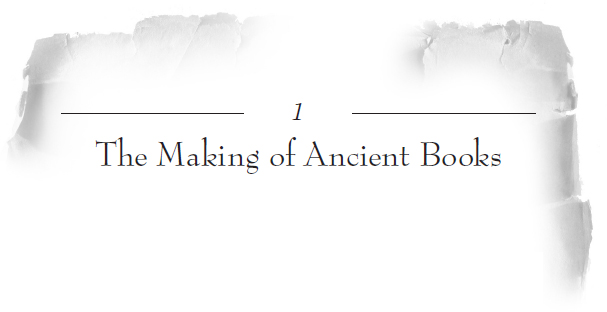

ow the Bible has come down to us is a story of adventure and devotion. It is a story of toil and faith by those who, sometimes at great cost, passed down from generation to generation the message of salvation. The Bible did not just happen nor has it been preserved through the years by mere chance. Living in a day when books are written and printed by the thousands, we are apt to overlook the fascinating drama that lies behind our Bible.
How and when did the books of the Bible have their origin? In what sense are these books different from other books? How have these books been preserved and transmitted to us? These are some of the questions that arise in the mind of every thoughtful student of the Bible. The answers to these questions tell a story which spans thousands of years and takes us to various regions of the world and into the hearts of countless unnamed people whose first love was the Word of God.
The starting point of our Bible is preceded and determined by another storythe history of ancient books and writing. It is necessary to know this story because the Bible is composed of documents which were not only written long ago but have been transmitted and preserved through the years by means of writing. Knowing something of the early history of writing and the origin of ancient books will provide an interesting background for the history of the Bible and at the same time contribute immeasurably to an understanding of the life situations in which the Word of God had its birth.
Early Writing
Our Bible is a very old book, but it is by no means the oldest book in the world. Discoveries made in recent times show that writing was a well-established art in many countries long before the beginnings of the Hebrew nation in the land of Palestine. The earliest known examples of writing carry us into the ancient land of Egypt and Mesopotamia. We do not know exactly when or where writing began. Certainly no one sat down and said, I am going to invent the art of writing. What we do know is that, as attested by an abundance of clay tablets, writing was widespread in Mesopotamia at least by 3000 B . C . We know also that Egyptian texts reach farther back and have survived in hieroglyphs on monuments, temples, and tombs.
Next page
